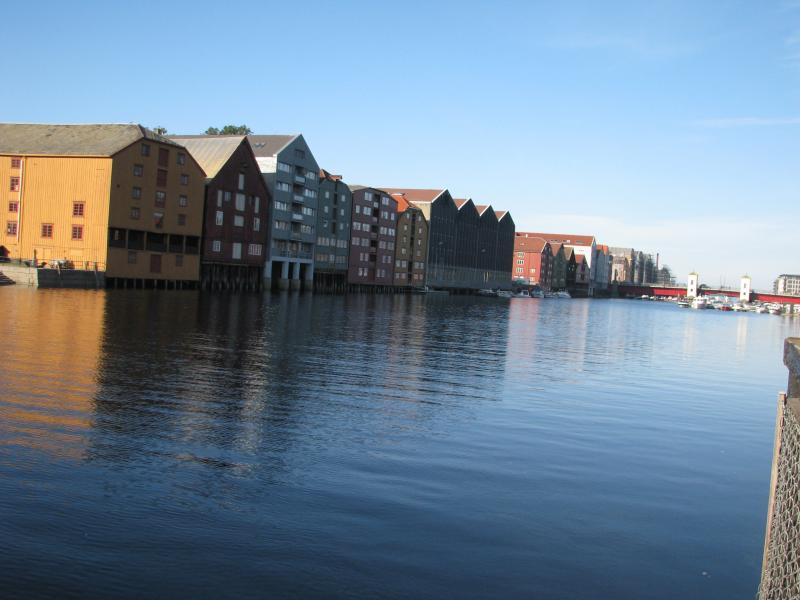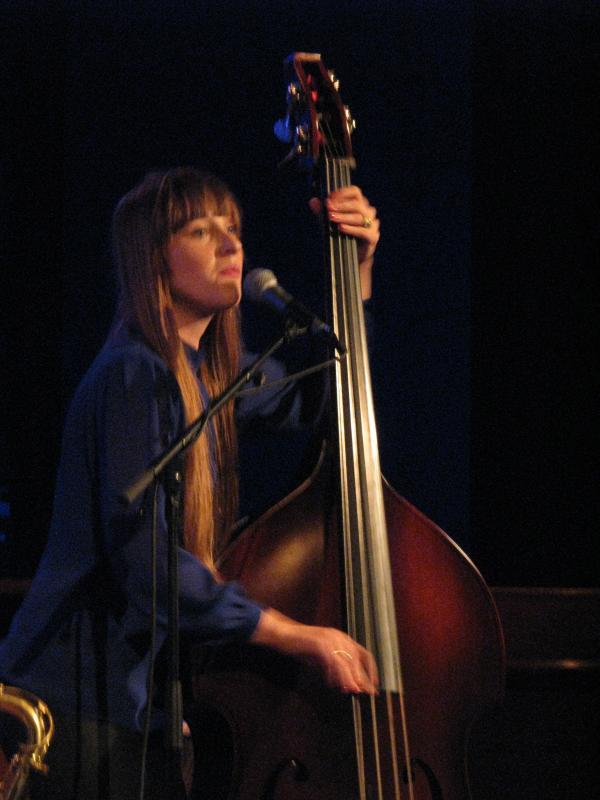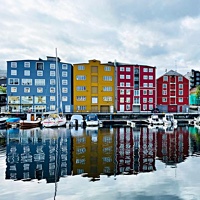Home » Jazz Articles » Live Review » European Jazz Network General Assembly 2013
European Jazz Network General Assembly 2013
Europe Jazz Network's General Assembly 2013 + Young Nordic Jazz Comets + Norwegian Jazz Nights
Trondheim, Norway
September 12-15, 2013
Europe Jazz Network (EJN), founded 26 years ago in Ravenna, Italy, is a pan-European association of producers, presenters, and supporting organizations engaged in presenting and promoting the creative art form of contemporary jazz and improvised music. Its membership includes 89 organizations (festivals, clubs and concert venues, independent promoters, and national organizations) in 28 countries.
From Bari to Trondheim
Last year the Federation met in Bari in the Puglia region of South Italy for its twenty-fifth annual assembly. This year's assembly took place about 3300 kilometers north of Bari, in Trondheim, Mid Norway, organized by Midnorsk Jazzsenter. Jazz activities in Norway are spread among three regional zones (south, mid, north) which is not surprising given the extent of the country. Horizontally getting smaller half way up north, the mainland of Norway stretches from 13°N to 58°N at the western periphery of Europe. Driving from Kristiansand in the south to North Cape covers about 2,500 km, plus Norway has 50,000 islands off the coast, including the Arctic archipelago of Svalbard at 71°N.
Trondheim as the third largest city of Norway is a center of intelligence in science, engineering and technology but above all it is historical ground concerning Norwegian history and identity in general and jazz/music specifically. Trondheim started the first Norwegian jazz-education at the end of the seventies of the last century which is now part of the Music Department of Norwegian University Science and Technology (NTNU). Trondheim with its 30.000 students is characterized by a unique combination of scientific- technical and musical excellence. The city also houses Norway's national museum for music and musical instruments with a collection from around the world and in the impressive new Rockheim building the national center for pop and rock music.
The Music department and its predecessors delivered a large number of well-known musicians of the middle and young generation as Nils Petter Molvaer, Arve Henriksen, Mathias Eick, Hakon Kornstad, Trygve Seim, Tore Brunborg, Daniel Herskedal, Kjetil Møster, Mats Eilertsen, Ole Morten Vågan, Per Zanussi, Ola Kvernberg, Thomas Strønen, Paal Nilssen-Love, Per Oddvar Johansen, Gaard Nilssen, Ingar Zach, Christian Wallumrod, Stale Storløkken, Eldbjorg Raknes, Kristin Asbjørnsen, etc. etc., names which indicate a noteworthy diversity of temperaments and temperatures in their ways of music making. They all immersed themselves in the special Trondheim learning environment which produced a remarkable output of musicians over the last three decades.
This is related to and might be described as creativeness fuelled by independent and confluent mindsets of young people coming from places all over Norway, all with their own strong identity. Young people encouraged to act in that spirit are used to develop and maintain that. Norwegian identity, it seems, is not so much driven by forced uniting conformism but by a tacitly shared consensus of their rooted peculiarity as a core value and a necessary means of survival.
The Trondheim Meeting
Kristin Danielsen, chairman of Norwegian Jazz Federation, pointed in that direction in her opening-address and Erling Aksdal, professor at NTNU Department of Music in Trondberg and one of the founding fathers and advocates of the 'Trondheim-Model' gave some insight into the open oral approach connected to that mentality with its vivid spirit. That spirit affected the three days of conferencing dedicated to (a) education of jazz musicians, (b) knowledge of /insight in audiences, (c) jazz events with special experience- qualities, (d) general assembly and board meetings, (e) tasks and collaboration of jazz media in Europe, (f) next steps resulting from (a)—(e).

Upon arrival to Trondheim the city showed in bright, warm sunshine and blue sky, the perfect condition to stroll Bakklandet, Trondheim's old quarter along the curving Nidelva river with its restored old wooden buildings, originally workers houses. The quarter, just ten minutes walk from Rica Nidelven hotel on the other side of the river, was saved from city planners' modernization phantasies. The lively neighbourhood is now considered the heart of Trondheim's heritage and cultural identity.
Trondheim offered superb accommodation at Rica Nidelven hotel situated on the edge of the former shipbuilding area and renowned for its high quality food and kitchen. The concert-venue at the old dock house on just five minutes walking distance had excellent sound quality and a pleasant, inspiring atmosphere. The Dokkhuset venue was populated by young audiences and even though it was packed at most of the concerts it remained comfortable because of people's care and flexibility.
The Trondheim meeting had a pleasant rhythm of activities, provided a climate and environment of free flow of ideas, good examples, illustrative material, interested and patient listening as well as fruitful discussion and yielded some good and useful results. This especially applies to the media-group Europe Jazz Media (EJM) which achieved remarkable progress concerning collaboration and concrete perspectives of future development—the miraculous Trondheim turning point. The practice of various festivals and venues were presented (Tampere Jazz Happening, Northseajazz Rotterdam, Bimhuis Amsterdam) as well as festival-contexts with special experience- qualities (Jazz Biketour Groningen (NL), N.A.T.U.R Bochum (G) and Earwax Gent (B)) which both provided a useful basis for further discussion and development of ideas and projects.

The three concert-nights with fourteen concerts took place at the Dokkhuset venue, an old dock house in the now transformed former shipbuilding area of Ørens Mekaniske Verksted and Trondheims Mekaniske Verksted, once the largest employer in Trondheim. When the industrial site became disused in the late 1990s, it was turned into a new high-end area with some of the original buildings and artifacts like the canal and one of the old cranes kept there as integral part of it.
First concert night: all Scandinavian
The first night at Dokkhuset, packed with a young local audience, presented an all Scandinavian program entitled "Young Nordic Jazz Comets" (YNJC). It offered surprising music by young musicians from Zweden, Faroe Islands, Finland, Iceland, Norway and Denmark (only Greenland missing!). The YNJC event started in 2000. Through the years it changed from an annual competition to a program with full (showcasing) concerts. It operates in a similar spirit as Dublin's new Pan-European 12 Points festival.
Six bands performed: Casey Moir Band from Sweden, Bárdur Reinert Poulsen Kvartet from Faroe Islands, Kadi Quartet from Finland, Skarkali Trio from Iceland, Pixel from Norway and Crunch House from Denmark—four quartets, the (classical) piano-trio from Iceland and the Crunch House duo (drums, hammond B3) from Denmark. Two of the quartets had a fronting female vocalist (Casey Moir and Kadi Vija). In Pixel, Ellen Andrea Wang combined her double bass playing with singing.
Casey Moir played a sophisticated set with extreme leaps and wild rides, skillfully performed. Their music showed lots of good ideas but was a bit overloaded in the workout. Singer Moir at times was acting weird instead of giving way to the feeling of real madness. Bassist Poulsen's group (with Kjetil André Mulchid as impressive alto- saxophonist) played with a lot of verve, urgency and heat. It finished with an infectious kind of Faroe lambada. Poulsen, still studying in Trondheim, hopefully will be the first director of a jazzfestival on the far remote islands. Kadi Vija, a selfconscious singer with a firm throat, led her band through an energetic and powerful set. She dared to pause, drop silences and increased tension and dynamics. The Icelandic piano-trio Skarkali (Ingi Bjarni, p, Valdimar Olgeirsson, b, Óskar Kjatansson, dr) had to face maybe the biggest challenge by adopting this classical format. Apparently the threesome chose to work its way through in a classical way. It reached a respectable level with moments of beautiful melodicism and has still a way to go.

Second concert night: Norwegian Jazz
Norwegian jazz was presented the second and third night. Each night had four groups with every night an internationally highly acclaimed local ensemble as main anchor: Trondheim Jazz Orchestra and Trondheim Voices.
Hard rocking electric guitarist Hedvig Mollestad Thomassen together with her fellow musicians bassist Ellen Brekkenand and drummer Ivar Loe Bjørnstad set the ball rolling. Brekken had a mighty springy bass sound, Bjørnstad not only hit hard but kept space open. Blue Cheer or The Melvins might be the first association. They call themselves 'trio' which is a bit strange for a combination playing classical loud and screaming guitar- rock. But it was not simply old time guitar-rock that they played. Within a compact approach the group played with the sounds and images of old time hard rock, made the music sound airier, clearer and more driving. They put in more space and worked through a series of clever recombinations with well known riffs surfacing at surprising moments. This time the threesome operated sharply on the edge with brilliant interplay. Mollestad released two guitar-albums with this trio on Rune Grammofon, Shoot! and All Of Them, Witches.
Next was Cortex, a high potential group not so well known yet that should rapidly change after their Trondheim performance. Aylerian rawness, screams, forward motion and full brassy sound of highly attractive melodic lines go together in their very own marvelous group sound. Their finishing piece "Mitotic Cycles" fully confirmed their reputation. It was the best derivation of Juan Tizol's Caravan I have heard in some time. Cortex is Thomas Johansson on trumpet, Kristoffer Berre Alberts, sax, Ola Høyer, bass, and Gard Nilssen on drums. Johannsson is just one more brilliant Norwegian trumpet-player in a seemingly endless row. Gaard Nilssen has become one of the most busy Norwegian drummers and key figure for the younger generation. Shortly Cortex will tour North America (29/11—12/12) together with another, guitar-driven group Gaard Nilssen takes part in, namely Bushman's Revenge. After touring Norway, Sweden, Germany, Belgium, France, Italy and Japan, last year Cortex released its second album, Göteborg on Gigafon Records.

Cortex was followed by the trio of pianist Vigleik Storaas with bassist Bjørn Kjellemyr and drummer Per Oddvar Johansen, all renowned and highly respected first class musicians of the older generation. The trio with strong Trondheim connections—Storaas is a Trondheim Music Department professor and Johansen an alumnus—played a rich and subtle set with lots of folk-themes. It was remarkable how eager and intensively engaged the mainly young audience listened to the quiet and restrained rendition of the trio. The trio's wonderful performance is another testimony of the rich musical quality to discover behind the Norwegian forefront.
The top trump card, Trondheim Jazz Orchestra, had not even been brought in yet. Together with Norwegian shooting star, saxophonist Marius Neset, the twelve piece orchestra (Ronny Farsund—trumpet, Eivind Lønning—trumpet, Eirik Hegdal—saxophones, Erik Johannessen—trombone, Daniel Herskedal—tuba, Peter Fuglsang—alto saxophone, Hanna Paulsberg—tenor saxophone, Jovan Pavlovic—accordion, Espen Berg— piano, Petter Eldh—bass, Gard Nilssen—drums, David Solheim—sound design) then brilliantly covered the finale of the first night. The orchestra which had collaborations with the likes of Chick Corea, Joshua Redman or Pat Metheny—to name a few just from memory—has launched an impressive variety of programs and plays a busy schedule. But the TJO is not primarily a big names enterprise. At this year's Molde Festival for instance a commission work by young Norwegian duo Albatrosh was premiered with TJO. The Neset-program was premiered at last years' Molde festival. Consequently a list of different younger musician has been enabled to realize orchestral work. By this the orchestra itself could make its way into new territories and new of ways of shaping music in the field of jazz. Its pioneering work has been highly appreciated internationally. Programming this ensemble seems almost inescapable for those who are on track and eager to serve their audience by exciting and challenging musical quality. The performance this night was no routine. The orchestra played up to its reputation fired by Neset's enormous energy, high precision and drive.
Third concert night: Norwegian Jazz
The last night was opened by the other Trondheim cornerstone, Trondheim Voices, a ten female vocalists ensemble (Torunn Sævik, Siri Gjære, Sissel Vera Pettersen, Ingrid Lode, Live Maria Roggen, Kirsti Huke, Heidi Skjerve, Anita Kaasbøl, Silje Karlsen, Tone Åse). Its fascinating loosely semi-improvised work unfolds during perpetual movement of the ensemble members through the performance space. It can be a conventional stage as in this case but also other kinds of architectural or natural spaces. Trondheim Voices surprised and pleased many spectators by their highly appealing way of melding new approaches of vocalism in a version of their very own creative signature. Its performance was a convincing manifestation how daring experiments lead into viable formats.

Benjamin Mørk from the subarctic region of Tromsø fuses Nordic melodicism into plain repetitive rock bases enriched by layered instruments. Clearly influenced by the work of Eivind Aarset and Arve Henriksen he has found his way into his own dark pulse, hidden drama and hovering sentimentality. His group Mørk (Kristian Olstad, guitar, Dag Okstad, b, Christer Jørgensen, dr) delivered a compact version of these new colors with its potential to cut deeper. Albatrosh, the duo of pianist Eyolf Dale and saxophonist Andre Roligheten played a bold and entertaining set which confirmed their already well known first-rate quality. It seems they can do everything without losing track or tension.
The last band of the night was Sommerfuglfisk, literally 'summerbirdfish,' a trio of classical rock line-up of guitar, bass guitar and drums. Unknown to the international guests, they turned out to be a real, unexpected surprise. Sounding more like an updated version of Edi Brickell's New Bohemians, they did not fit into any of the commonly known Nordic soundworlds. In their combination of solid

body and airy light-heartedness they convincingly slid through African, Caribbean, rock and blues territories. The obvious self consciousness, sense of humor, looseness and virtuosity of the threesome of guitarist/vocalist Nina Kristine Linge, electric bassist Dan Peter Sundland and drummer Hans Hulbækmo enchanted the audience—apparently leading to a couple of spontaneous bookings directly after the show.
Prospect
Next day The Fjords performed on Munk's Islet (Munkholmen). I had to leave out the excursion to the fortress and former jail-house because I departed to Sjøbygda, an artists' residence deep in the woods at Selbu Lake (Sør-Trøndelag, Norway), one and a half hours from Trondheim.
Among the fourteen bands there were complex vocalized textures, heavily rock- infused bands, classical piano-format, sharp sounds with slight overdrive and freely flowing cross-sectional rides, lots of good horns but no really bizarre extravaganza or outstanding provocative personalities. A promising and also trendsetting selection. Together with the discussed music events a good point of departure for Helsinki, Finland where next year's assembly will take place.
< Previous
Frames
Next >
Shiny Metal Objects
Comments
Tags
Live Reviews
Henning Bolte
Norway
Trondheim
Nils Petter Molvær
Arve Henriksen
Mathias Eick
Hakon Kornstad
Trygve Seim
Tore Brunborg
Daniel Herskedal
Mats Eilertsen
Per Zanussi
Ola Kvernberg
Paal Nilssen-Love
Per Oddvar Johansen
Ingar Zach
Christian Wallumrød
Eldbjörg Raknes
Jonas Ladegaard
Emil Savery
Hedvig Mollestad
Kristoffer Berre Alberts
Ola Høyer
Gard Nilssen
Bjørn Kjellemyr
marius neset
Eivind Lønning
Erik Johannessen
hanna paulsberg
Petter Eldh
Chick Corea
Joshua Redman
Pat Metheny
Eyolf Dale
André Roligheten
Hans Hulbækmo
For the Love of Jazz
 All About Jazz has been a pillar of jazz since 1995, championing it as an art form and, more importantly, supporting the musicians who create it. Our enduring commitment has made "AAJ" one of the most culturally important websites of its kind, read by hundreds of thousands of fans, musicians and industry figures every month.
All About Jazz has been a pillar of jazz since 1995, championing it as an art form and, more importantly, supporting the musicians who create it. Our enduring commitment has made "AAJ" one of the most culturally important websites of its kind, read by hundreds of thousands of fans, musicians and industry figures every month.






















